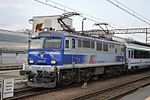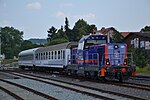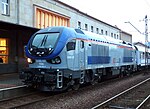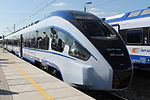PKP Intercity
 | |
| Company type | JSC |
|---|---|
| Industry | Rail transport |
| Founded | 1 January 2001 |
| Headquarters | Warsaw, Poland |
Key people | Marek Chraniuk CEO |
| Products | Express Intercity Premium (EIP) Express Intercity (EIC) Intercity (IC) Twoje Linie Kolejowe (TLK) |
| Services | Long-range and international passenger transport |
| Revenue | 2,950.5 million zł |
| 186.4 million zł | |
| 141.1 million zł | |
| Total assets | 5,992.6 million zł |
Number of employees | 8,936 [2] |
| Website | Official website |
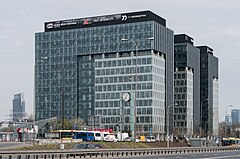

PKP Intercity is a company of PKP Group responsible for long-distance passenger transport. It runs about 350 trains daily, connecting mainly large agglomerations and smaller towns in Poland. The company also provides most international trains to and from Poland. Trains offer Wi-Fi connectivity.
History
PKP Intercity came into existence as a result of a major restructuring of the state-owned Polish railway operator Polskie Koleje Państwowe which, in 2001, was divided up into several different companies that were most operated as independent entities on a commercial basis.[3] Amongst other factors, this reform has the objective of separating railway operating activities from the management of Poland's railway infrastructure. PKP Intercity is a subsidiary of PKP Group, a state-owned holding company for various other railway-orientated subsidiaries.[3]
An early distinctive feature of PKP Intercity over that of other passenger operators was the intentional emphasis on implementing a new standard of service upon Poland's railways.[3] Trains operated under the InterCity brand typically have the highest comfort offered to the traveling public, featuring onboard snacks and air conditioning throughout amongst other amenities. Over time, the range of services operated by PKP Intercity has expanded; in 2005, PKP Intercity launched the TLK (Lowcost Trains) brand, an alternative service level intended for less affluent passengers.[4]
During 2006, PKP Intercity inaugurated its first modern Customer Service Centre at Warsaw Central station; one year later, the second such facility was opened at Poznan.[4] By the late 2000s, it operated the highest segment of passenger traffic services in country; during 2007, PKP Intercity recorded the transportation of 11.6 million passengers for that year, up by almost one million over the 10.7 million passengers recorded for 2006.[3] By 2007, it was drawing up plans to purchase new locomotives and to further upgrade existing rolling stock; furthmore, PKP Intercity reportedly pursues quality levels equivalent to the highest standards in the European Union.[4]
During May 2011, PKP Intercity awarded a contract valued at €665 million to the French rolling stock manufacturer Alstom covering the manufacture and supply of 20 ED250 New Pendolino high speed trains, as well as the provision of all maintenance activities for up to 17 years and the construction of a new maintenance depot.[5][6] These trainsets, each comprising seven cars, were built to PKP Intercity's individual specification; while capable of attaining a maximum speed of 250 km/h, carrying up to 402 passengers, and incorporating various noise minimisation measures, they intentionally excluded the optional tilting mechanism.[7][8]
On 17 November 2013, a new speed record for Polish railways was set when the Pendolino ED250 reached a speed of 291 km/h (181 mph).[9] Furthermore, on 24 November 2013, the final day of tests on the CMK Central Rail Line, the Pendolino reached 293 km/h (182 mph).[10] On 11 September 2014, Polands's Railway Transport Office (UTK) announced that the ED250 had been certified for operation at up to 250km/h in accordance with the relevant Technical Specifications for Interoperability (TSI).[11][12] They are operated on existing conventional lines between major city groups such as Warsaw-Gdansk-Gdynia, Warsaw-Krakow, and Warsaw-Katowice, delivering significantly shortened journey times over traditional rolling stock, traversing the route between Warsaw and Gdansk in two and a half hours.[7] In the 2020/21 timetable, ED250 routinely operated at a scheduled speed of up to 200 km/h (124 mph) along selected stretches of the Warszawa - Gdynia and Central Rail Line routes.[13]
Various other schemes were underway during the late 2010s, such as the retrofitting of Wi-Fi apparatus throughout the various types of rolling stock to provide passengers with mobile internet access, having completed work on 171 PKP Intercity cars and 40 combined sets by August 2018.[14] One year later, a contract valued at €247 million of the contract was issued by PKP Intercity to the Swiss rolling stock manufacturer Stadler Rail for the manufacture and delivery of 12 Stadler FLIRT electric multiple units in an eight-car long distance configuration as well as a 15-year maintenance period; these feature both first class and second class compartments along with an onboard lounge bar area and accessibility adaptions for persons of reduced mobility.[15]
Operations
The company runs the following train categories:
- Express InterCity Premium (EIP, EIC Premium) – domestic exclusive high-speed trains (ED250 New Pendolino) between major cities with obligatory reservation.
- Express InterCity (EIC) – high-standard express trains between major cities and popular tourist destinations:
- InterCity – affordable high-standard express trains and fast trains with obligatory reservation; higher standard and priority than TLK but the same fare. Exclusive high-standard express trains - Pesa Dart and Stadler Flirt also run under the InterCity brand.
- Twoje Linie Kolejowe (TLK, "Your Rail Lines"; formerly called Tanie Linie Kolejowe, "Cheap Rail Lines" from 2005 to 2011) – affordable fast trains with obligatory reservation (with some exceptions); lower standard than InterCity. Some overnight TLK trains such as Przemyślanin and Ustronie provide couchette and sleeper cars. A limited number of shorter-route TLK trains is 2nd-class only. Usually run by locomotive-hauled rakes and more rarely Pesa Bydgostia EMUs.
- Międzynarodowy (M) – international fast train (lower standard than EuroCity)
- Międzynarodowy nocny – international night train (lower standard than EuroNight)
Rolling stock
Electric locomotives
| Class | Number | Speed | Manufacturer | Modernized | |
|---|---|---|---|---|---|
| EP05 | 1 | 160 km/h | Škoda | ZNTK Gdańsk | [16] |
| EU07 | 227 | 125 km/h | Pafawag / HCP | [17] | |
| EP07 | 125 km/h | Pafawag / HCP | ZNTKiM | [17] | |
| EU07A | 3/23 | 160 km/h | HCP | ZNTK Oleśnica/Olkol | [18] |
| EP08 | 9 | 140 km/h | Pafawag | [16] | |
| EP09 | 46 | 160 km/h | Pafawag | [16] | |
| EU44 | 10 | 230 km/h | Siemens | [16] | |
| EU160 | 30 | 160 km/h | Newag | [19] | |
| ? | 0 out of 10 | 200 km/h | Newag | [20] | |
-
EP05
-
EU07
-
EP07
-
EU07A
-
EP08
-
EP09
-
EU44 Husarz
-
EU160 Griffin
Diesel locomotives
| Series | Type | Number | Speed | Manufacturer | Modernized | |
|---|---|---|---|---|---|---|
| SM42 | 6D | 30 | 90 km/h | Fablok | [16] | |
| SM42 | 18D | 10 | 90 km/h | Fablok | Newag | |
| SU42 | 6Dl | 10 | 90 km/h | Fablok | Newag | |
| SU160 | 111Db | 10 | 140 km/h | Pesa | [21] | |
| SM60 | EFIShunter 300 | 0 of 10 | 60 km/h | CZ Loko | [22] | |
-
SM42 (6D)
-
SM42 (18D)
-
SU42
-
SU160 Gama
Electric multiple units
| Series | Number | Number of units | Speed | Manufacturer | |
|---|---|---|---|---|---|
| ED74 | 14 | 4 | 160 km/h | Pesa | [16] |
| ED160 | 20+ | 8 | 160 km/h | Stadler Polska | [23] |
| ED161 | 20 | 8 | 160 km/h | Pesa | [24] |
| ED250 | 20 | 7 | 250 km/h | Alstom | [25] |
-
ED74 Bydgostia
-
ED160 FLIRT3
-
ED161 Dart
-
ED250 Pendolino
See also
References
- ^ a b c d "PKP Intercity". PKP Group Annual Report 2019 (PDF). PKP. pp. 52–61. Retrieved 8 September 2021.
- ^ Rzeczpospolita, 24 November 2022
- ^ a b c d "The PKP family is working in harmony". globalrailwayreview.com. 28 May 2008.
- ^ a b c "Poland provides popular rail services". globalrailwayreview.com. 6 June 2007.
- ^ "PKP Intercity signs Pendolino contract". Railwaygazette.com. Retrieved 29 July 2018.
- ^ "PKP Intercity zamawia 20 pociągów New Pendolino". Gazetakrakowska.pl. 30 May 2011. Retrieved 29 July 2018.
- ^ a b "Alstom to supply and maintain a fleet of 20 New Pendolino trains for PKP Intercity". globalrailwayreview.com. 30 May 2011.
- ^ Kolejowy, Kurier. "Pendolino bez homologacji. Od jutra będą kary". Kurierkolejowy.eu. Retrieved 29 July 2018.
- ^ "291 km/h. Nowy rekord prędkości polskiego Pendolino". Tvn24.pl. Retrieved 29 July 2018.
- ^ "Wszystko na temat branży kolejowej: PKP, Intercity, przewozy regionalne, koleje mazowieckie, rozkłady jazdy PKP, Kolej". Rynek-kolejowy.pl. Retrieved 29 July 2018.
- ^ Barrow, Keith (17 September 2014). "Polish Pendolinos gain 250km/h certification".
- ^ "Polish high speed rail project cancelled". Railwaygazette.com. Retrieved 29 July 2018.
- ^ "Rekordowo szybkie Pendolino. Od grudnia z Warszawy do Gdańska w dwie i pół godziny".
- ^ "Pendolino trains in Poland soon to receive Wi-Fi from Alstom". globalrailwayreview.com. 29 August 2018.
- ^ "Stadler delivers further trains to PKP Intercity in Poland". globalrailwayreview.com. 23 August 2019.
- ^ a b c d e f Chiżyński, Jacek (2011). Atlas przewoźników kolejowych Polski 2011 [ABC Railway Carriers of Poland 2011]. Rybnik: Eurosprinter. ISBN 978-83-931006-5-1. OCLC 838650982.
- ^ a b "PKP Intercity wydłużają czas na przygotowanie lokomotywowych ofert". inforail.pl (in Polish). Retrieved 14 November 2020.
- ^ "PKP Intercity wyda 200 mln zł na przebudowę lokomotyw do prędkości 160 km/h". Rynek Kolejowy (in Polish). Retrieved 14 November 2020.
- ^ "Komplet Griffinów dla PKP Intercity" [All Griffins for PKP Intercity delivered]. TransInfo (in Polish). 27 November 2020.
- ^ "Newag wins the tender for the supply of 10 multi-system locomotives". Railway Supply. 3 August 2021.
- ^ "Wszystkie Gamy dla Intercity dostarczone". Rynek Kolejowy (in Polish). Retrieved 14 November 2020.
- ^ ms (15 February 2021). "PKP Intercity kupuje 10 lokomotyw manewrowych od CZ Loko" [PKP Intercity orders 10 shunters from CZ Loko]. Rynek Kolejowy (in Polish). Retrieved 8 September 2021.
- ^ "Wszystkie Flirty3 odebrane przez PKP Intercity". inforail.pl (in Polish). Retrieved 14 November 2020.
- ^ "Ministerstwo Rozwoju: dotacja UE na tabor z Pesy całkowicie wykorzystana". Rynek Kolejowy (in Polish). Retrieved 14 November 2020.
- ^ "Infobus". infobus.pl (in Polish). Retrieved 14 November 2020.




